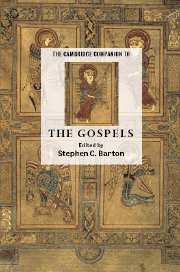Book contents
- Frontmatter
- Introduction
- Part I Approaching the gospels: context and method
- Part II The gospels as witnesses to Christ: content and interpretation
- 6 The Gospel according to Matthew
- 7 The Gospel according to Mark
- 8 The Gospel according to Luke
- 9 The Gospel according to John
- Part III The afterlife of the gospels: impact on church and society
8 - The Gospel according to Luke
from Part II - The gospels as witnesses to Christ: content and interpretation
Published online by Cambridge University Press: 28 January 2007
- Frontmatter
- Introduction
- Part I Approaching the gospels: context and method
- Part II The gospels as witnesses to Christ: content and interpretation
- 6 The Gospel according to Matthew
- 7 The Gospel according to Mark
- 8 The Gospel according to Luke
- 9 The Gospel according to John
- Part III The afterlife of the gospels: impact on church and society
Summary
Of the four canonical gospels, only the Gospel of Luke begins with a direct explanatory declaration (Lk 1.1-4). The first sentence is a concentrated statement, constructed in an aesthetically pleasing style, drawing on the complexities of Greek syntax. This sentence has been carefully crafted, the vocabulary has been judiciously selected, and distinct literary conventions from the Hellenistic period have been employed to disclose the intentions of the author. In this sentence - the only time the authorial first person singular is used in this gospel - the author articulates his view of the literary nature of the work, the method used in writing it, his main purpose in writing, and the audience he had in view. (The similar first-person style of Acts 1.1-5 stamps it as an additional authorial declaration at the start of the companion volume to the gospel.)
Literary nature
What kind of literature does the author write? Earlier claims that the canonical gospels are sui generis, being comparable to no known literature of the time, have given way to discussions of the gospels in relation to other forms of Hellenistic literature. Lk 1.1–4 bears many formal similarities to prefaces found in ancient scientific and technical manuals.
- Type
- Chapter
- Information
- The Cambridge Companion to the Gospels , pp. 158 - 181Publisher: Cambridge University PressPrint publication year: 2006
- 1
- Cited by



